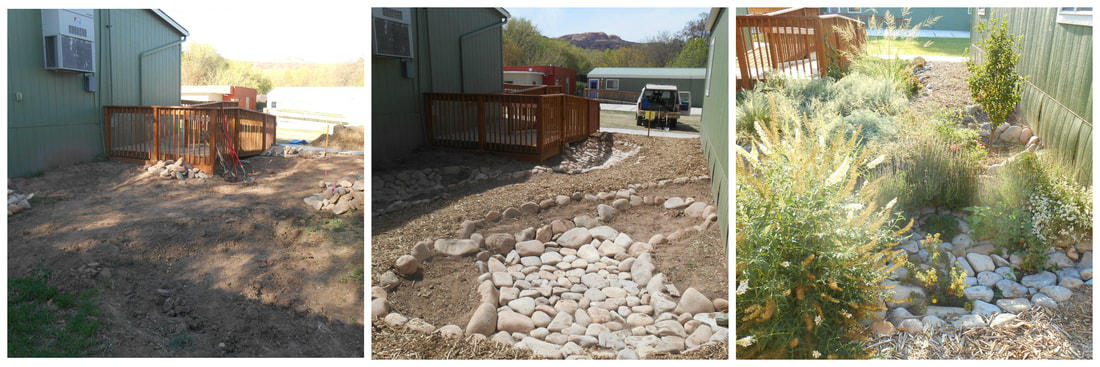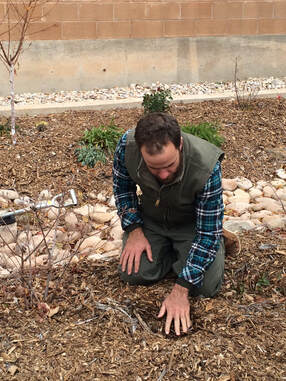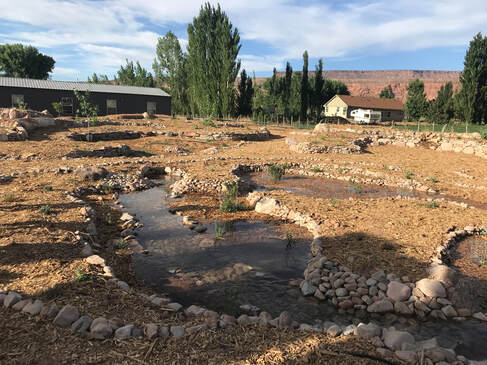TerraSophia

With my toddler secured in our bike trailer, we take off each weekday on our morning errands past the greywater-fed basins of our house. Those basins bear cherry, apricot, and nectarine trees, currants, lavender, and a range of pollinator attractors and native grasses, all of which are surrounded by a thick, fungal-rich mulch layer. Jeff Adams of TerraSophia, LLC, helped turn my greywater dreams into reality by sizing and implementing catchment basins for our laundry, shower and bath water and integrating them into a permaculture concept design for my property.
I first met Jeff while taking my Water Harvesting Certification in Albuquerque, NM with the Tucson-based Watershed Management Group. He was teaching alongside Brad Lancaster and other experienced leaders in systems thinking and regenerative design, and I was a professor-turned-student in his class, writing math equations for roof rainwater runoff and soaking in the information like a water-thirsty sponge. At the time, my husband and I were building our straw-bale, solar PV, passive solar house in our walking-biking only neighborhood and I realized the potential of many things conveyed in the course, such as the usefulness of a large storage tank instead of a rain barrel for water catchment, and using a three-way valve and a two-inch pipe to gravity feed my laundry and bathwater to the landscape.
As my son and I leave our neighborhood, we pass landscape after landscape planted in a monoculture of resource intensive Kentucky bluegrass. While our cultural norms default to lawns – stemming back to our colonial roots – ecologically and socially beneficial alternatives to this degenerative pattern abound. Lawn signs read “Caution. Pesticide Application. Please Stay off Until Dry” with black and white images of an adult, dog, and a child accompanied by a large circle bearing a horizontal line across it. Stay off. Keep out. Toxic and unsafe.
During his teenage years, Jeff’s career path launched from this default-style of landscaping. In high school, he joined a landscaping crew and embarked in what he now calls “mow, blow and go.” We must ask ourselves: Are lawns easier? Just because we are used to buying lawnmowers or hiring landscaping crews, applying synthetic fertilizers, spraying pesticides, raking leaves, weed-whacking, and refueling with fossil fuels does not mean they are easy. They are habit. And ecologically and socially fruitful alternatives abound.
At Humboldt State University in Northern California, Jeff took a class in appropriate technology with topics ranging from greywater to passive solar to rocket stoves. It changed everything. Now, Jeff is restoring ecosystems and watersheds using permaculture design. Although he uses the term “ecological landscaping” on his website, Jeff loves the term permaculture. This is because “what I’ve realized is that as opposed to ecological design, as opposed to just regular landscape design - all these other design modalities - permaculture has ethical backing and a prime directive and that is really, really important…If you just picked up a landscape architecture/landscape design book, the process is pretty similar: You assess the site and the clients’ goals. You come up with a vision, you do some concepts and then you figure out the details. That part isn’t very different. [The difference is in] the underlying ethics and the prime directive to take responsibility.” This is where permaculture sets itself apart.

In defining permaculture, Jeff says “It’s a whole systems design method based on ecological principles and a whole range of traditional and modern techniques that is guided by ethics and has a prime directive to take responsibility for your actions. I usually try to emphasize as well that while it is most commonly thought of as gardening, landscaping, homesteading, food production, it is just as readily applied to business development, organizational development, interpersonal interactions or anything else because it is a design process. It’s not exclusive to one application or another but it takes a little more thinking outside of the box and creativity to say ‘how do some of these ecological principles and these ethics apply to my business’ or ‘how I decide to go do my errands in town so that I’m using the least amount of time and resources as I go about my 3 or 5 stops.’ That sort of thinking has permeated into my daily life so I try to share that with other people too…It’s almost more of a way of thinking and being than it is anything physical or tangible.”
Jeff does warn about expecting too much out of the Permaculture Design Certificate (PDC); “I think the PDC is an amazing life changing experience, but it’s just the beginning…we are dealing with very complex and in-depth systems as well as the design process as well as principles as well as the actual techniques and technical considerations and there is no way you can be proficient in that in two weeks…it’s an amazing starting point, but it needs to be better framed as a starting point.”
Along his path from a traditional landscaping crew to running his own ecological landscaping business for over a decade, Jeff has scaled up his work and its reach. He is now “really trying to work with institutions so that the work I do isn’t just tucked away in somebody’s backyard.” Albeit, he recognizes all designs are important in both their function and the potential of a ripple effect. His recent projects range from the residential to the watershed scale. In his spare time, Jeff works to influence and change local and state policy. Recently, he helped ensure green infrastructure was written into our city’s general plan and sustainability plan, and the two of us also partnered with our local health department to change (simplify) our state’s greywater policy.
We have much to learn from the way healthy ecosystems function, or the “wisdom of the earth,” which is in fact the meaning of TerraSophia. Such ecosystems are never operating in a monoculture; instead, they thrive with diversity. The same could apply to each of our landscapes and we could reap the added benefits of food production, wildlife encounters, and carbon sequestration. Thanks to educators like Jeff, more people are questioning the norm, removing their lawns, conserving water, and enjoying and distributing the bounty of permaculture.
To discover more about Jeff, visit TerraSophia’s website at: http://www.terrasophia.com

Recent Posts

